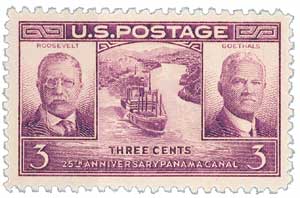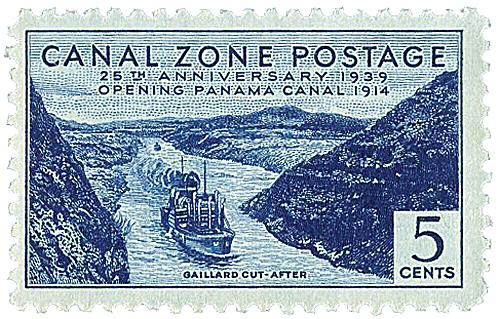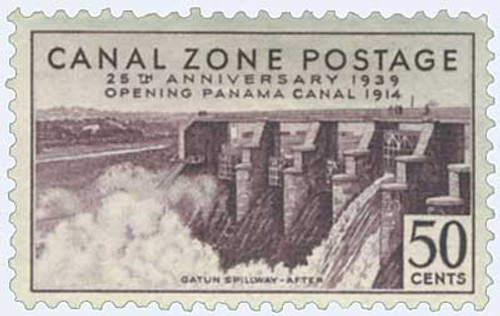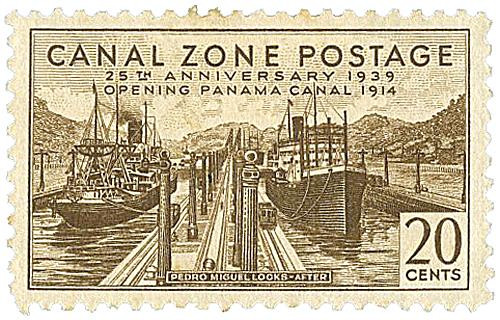
# CZ123 - 1939 5c Canal Zone - Galliard Cut After, Flat Plate Printing, unwatermarked, dark blue
CZ123 – 1939 5¢ Gaillard Cut
This stamp pictures the Gaillard Cut, which was named after Major David DuBose Gaillard. Gaillard was in charge of the Central Division, which included all of Gatun Lake and the Culebra Cut. Gaillard died of a brain tumor shortly before the Canal was completed, and Culebra Cut was officially changed to Gaillard Cut in his honor.
Galliard’s Cut was an American engineering feat dubbed the “Eighth Wonder of the World.” Cut through solid rock, the project was the critical task for the completion of the Panama Canal.
Opening Of The Panama Canal
For centuries, explorers, kings, and capitalists sought a way to cut their shipping times by cutting through the isthmus of Panama. In 1903, the United States helped Panama declare its independence from Colombia. President Theodore Roosevelt saw the creation of a canal across Panama as vital to America’s role as a global power. The following year began construction on the Eighth Wonder of the World – the Panama Canal. Roosevelt was so vested in the project that he visited the work site – making him the first sitting president to leave the continental U.S. during his term.
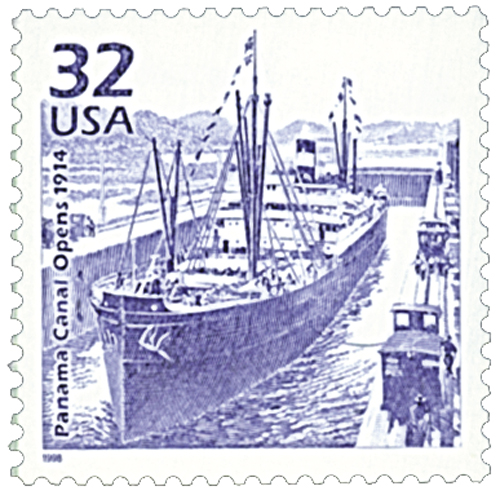
The construction was an arduous undertaking, costing the U.S. $375 million and 5,600 lives. Over the course of the 10-year project, over 75,000 people from the U.S., Barbados, Martinique, Guadeloupe, and other nearby islands braved the harsh conditions to help make the canal a reality.
A grand celebration was to be held on August 15, 1914, to celebrate the official opening of the Panama Canal. A fleet of international warships was to assemble off Hampton Roads, Virginia. From there, they would travel through the Panama Canal to San Francisco for the Panama-Pacific International Exposition.
CZ123 – 1939 5¢ Gaillard Cut
This stamp pictures the Gaillard Cut, which was named after Major David DuBose Gaillard. Gaillard was in charge of the Central Division, which included all of Gatun Lake and the Culebra Cut. Gaillard died of a brain tumor shortly before the Canal was completed, and Culebra Cut was officially changed to Gaillard Cut in his honor.
Galliard’s Cut was an American engineering feat dubbed the “Eighth Wonder of the World.” Cut through solid rock, the project was the critical task for the completion of the Panama Canal.
Opening Of The Panama Canal
For centuries, explorers, kings, and capitalists sought a way to cut their shipping times by cutting through the isthmus of Panama. In 1903, the United States helped Panama declare its independence from Colombia. President Theodore Roosevelt saw the creation of a canal across Panama as vital to America’s role as a global power. The following year began construction on the Eighth Wonder of the World – the Panama Canal. Roosevelt was so vested in the project that he visited the work site – making him the first sitting president to leave the continental U.S. during his term.

The construction was an arduous undertaking, costing the U.S. $375 million and 5,600 lives. Over the course of the 10-year project, over 75,000 people from the U.S., Barbados, Martinique, Guadeloupe, and other nearby islands braved the harsh conditions to help make the canal a reality.
A grand celebration was to be held on August 15, 1914, to celebrate the official opening of the Panama Canal. A fleet of international warships was to assemble off Hampton Roads, Virginia. From there, they would travel through the Panama Canal to San Francisco for the Panama-Pacific International Exposition.







